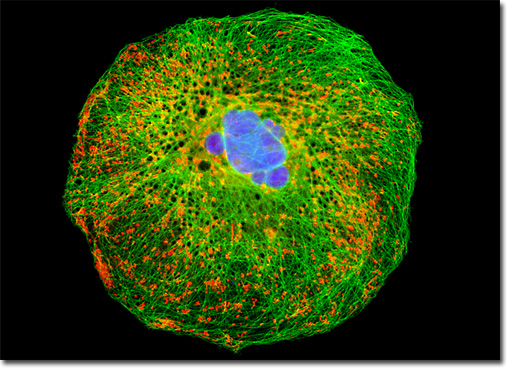Fluorescence Digital Image Gallery
Madin-Darby Ovine Kidney Epithelial Cells (MDOK)
|
Tubulin is the chief protein that comprises microtubules, which are found in the cytoskeleton as well as specialized structures, such as axonemes and basal bodies, that are involved in subcellular movements. The nonbranching, hollow microtubules are typically 20 to 25 nanometers in diameter, with a wall approximately 5 nanometers thick. This wall is composed of 13 globular protein subunits called protafilaments that are arranged circularly. Within the cell, microtubules are associated with a number of functions, including intracellular transport, maintenance of cell shape, movement, and the migration of chromosomes during mitosis and meiosis. Microtubules are often visualized for microscopy through the utilization of antibodies to tubulin conjugated with fluorescent dyes. The culture of sheep kidney cells (MDOK line) illustrated in the digital image above was immunofluorescently labeled with primary anti-tubulin mouse monoclonal antibodies followed by goat anti-mouse Fab fragments conjugated to fluorescein. The cells were simultaneously probed for DNA with the ultraviolet-absorbing probe Hoechst 33258, and for the mitochondrial network with MitoTracker Red CMXRos. Images were recorded in grayscale with a QImaging Retiga Fast-EXi camera system coupled to an Olympus BX-51 microscope equipped with bandpass emission fluorescence filter optical blocks provided by Omega Optical. During the processing stage, individual image channels were pseudocolored with RGB values corresponding to each of the fluorophore emission spectral profiles. |
© 1995-2025 by Michael W. Davidson and The Florida State University. All Rights Reserved. No images, graphics, software, scripts, or applets may be reproduced or used in any manner without permission from the copyright holders. Use of this website means you agree to all of the Legal Terms and Conditions set forth by the owners.
This website is maintained by our
|
